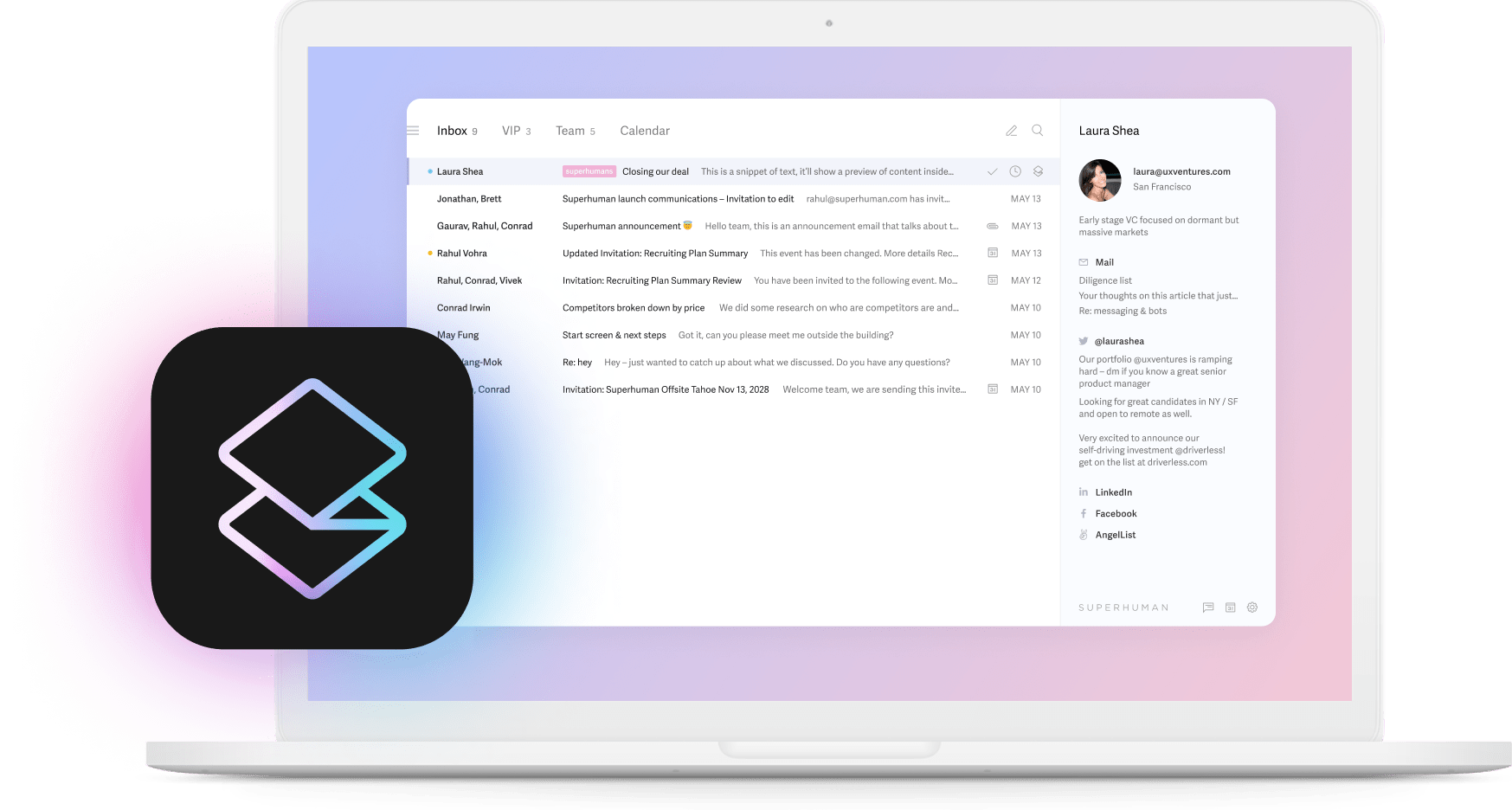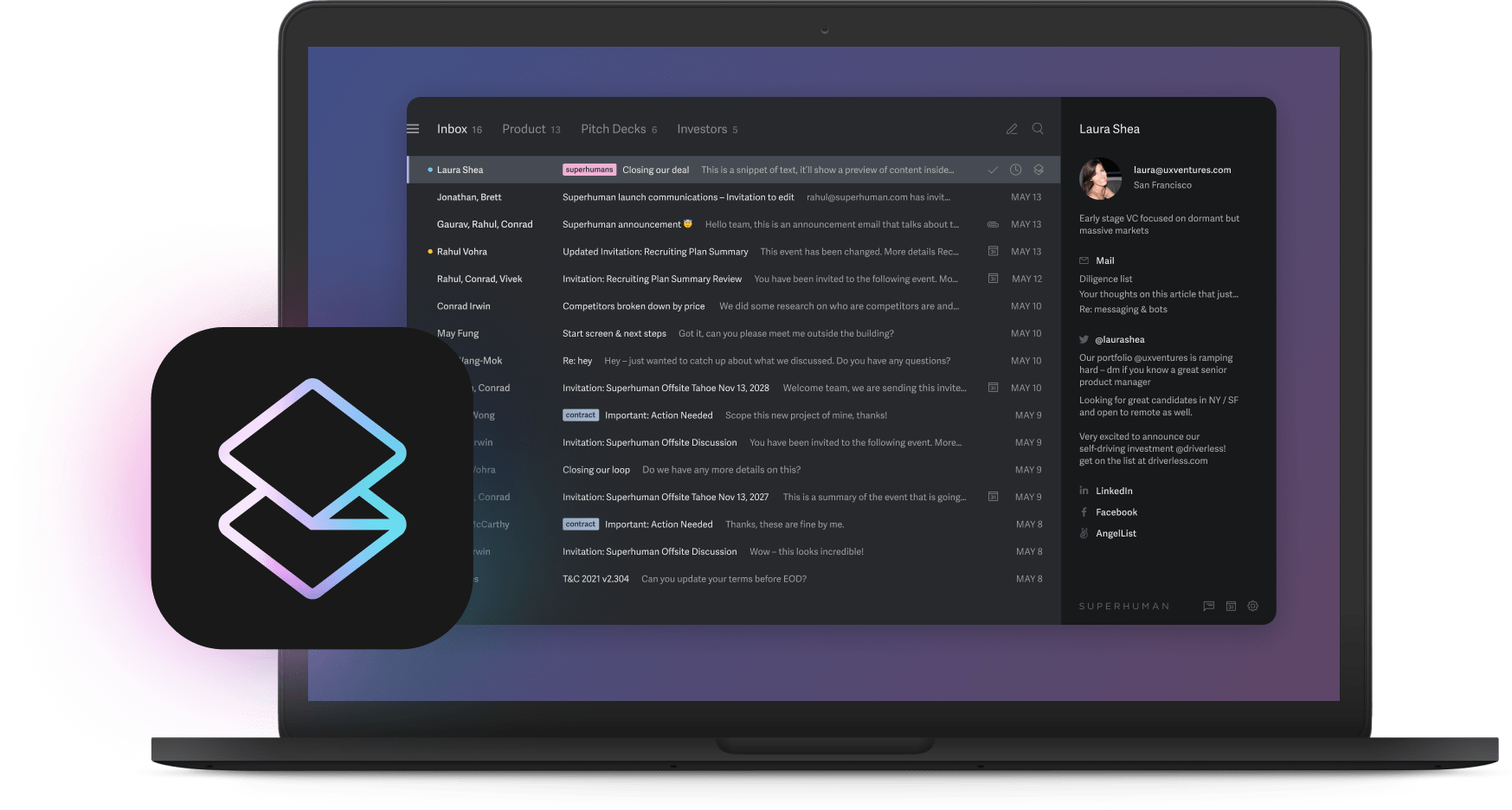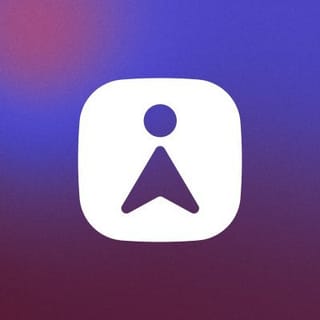
87% of business leaders say you need AI to compete, yet most companies are fumbling around with expensive pilots that go nowhere.
Here's the disconnect. Companies are chasing moonshots while missing the basics. They're building chatbots nobody uses while their teams drown in 600 emails a week. They're running AI experiments in labs while their best people waste half their day on routine tasks.
This guide cuts through the noise. We'll show you what works, what doesn't, and exactly how the winners are pulling ahead. Because while two-thirds of professionals expect productivity to triple in five years, the companies getting there first aren't waiting around. They're already saving a full day every week. And they started with something surprisingly simple.
What AI adoption means today
Let's clear something up. AI adoption sounds like you need to hire data scientists and build neural networks. You don't. The real winners are doing something much simpler. They're putting AI inside the tools everyone already uses.
Think about your day. You probably spend over half of it on email, messaging, and calendar apps. Most people do. We're talking dozens of hours just on email every week. That's where AI makes the biggest difference. When AI lives in these tools, people use it without thinking. No training sessions. No change management. Just better work.
The shift happened quietly. While everyone was debating whether AI would take jobs, it started doing something else entirely. It started giving people time back. B2B professionals using AI-native tools save an entire workday every week. We're talking about a 20% productivity increase from making existing tools smarter, not replacing them.
Here's what matters. Standalone AI apps force you to change your workflow. You have to remember to use them. You have to copy and paste. You have to context switch. AI-native tools make your current workflow faster. One creates adoption headaches. The other creates results. Industry leaders figured this out early. That's why they're 38% more likely to use specialized email apps instead of sticking with Gmail or Outlook.
How email became AI's perfect testing ground
Email was the obvious starting point. Most professionals spend 16.5 hours per week on it. Many handle over 600 emails weekly. Add it up, and you're looking at 100+ workdays annually just managing messages. Send 77 emails. Receive 100. Every single day.
For decades, email barely evolved. Sure, we have better spam filters. Search improved. But reading, writing, and organizing messages? Same old story. The cognitive load stayed massive. Every message required decisions. Read now or later? Respond immediately or schedule? Archive or delete? Multiply that by hundreds of messages, and you understand why email became where we lose our days.
Then AI changed everything. Not by replacing email, but by handling the repetitive parts. The early adopters figured it out first. Put AI in email, and people save 4 hours every week. Response times plummet. Message quality improves. Teams handle double the volume without burning out.
Companies that moved early are three times more likely to report major productivity gains. They didn't just get ahead. They rewrote the rules of how organizations communicate. While others debated AI ethics in boardrooms, these companies were shipping features that made their teams faster every single day.
The state of AI adoption in 2025
Where are we now? The experimentation phase is over. About 65% of B2B professionals use AI tools. And when they adopt them, they go all in. Nine out of ten use them daily. Over 70% use them multiple times throughout the day. This isn't tentative testing anymore. This is core to how work gets done.
The gap between leaders and everyone else keeps widening. Top companies use advanced email apps beyond Gmail or Outlook more often than others. Their best people use AI tools five or more times daily, 60% more often than average performers. But here's what's interesting. It's not just that they use AI more. They use it better. Top performers save 14% more time with the exact same tools.
Everyone knows what's coming. Two-thirds of professionals expect their productivity to triple within five years. Executives dream even bigger, with many expecting tenfold improvements. And most agree that AI isn't optional anymore. The question isn't whether to adopt AI. The question is whether you'll lead the charge or scramble to catch up.
We've crossed the line from experimentation to necessity. AI is now table stakes for staying competitive. Leaders even say "the ability to use technology strategically" is what sets top performers apart now. Not work ethic. Not strategic thinking. Technology mastery. That's the new differentiator.
Where AI creates business value
AI transforms businesses in four concrete ways. Let's break them down with real examples.
Operational efficiency
This one's simple math. Give people AI tools and they get a day back every week. But the impact goes deeper. When you save time weekly, that's 200+ hours annually. That's five work weeks. Imagine giving every person on your team an extra month each year. Not by working harder, but by working smarter.
Companies report their teams feel less stressed, more focused, and surprisingly, more creative. Turns out that when you're not drowning in busywork, you have space to think.
Enhanced decision-making
Top performers save time weekly because they use AI strategically. Consider what this means practically. A sales leader reviewing deal progress used to spend hours reading email threads. Now they can get instant summaries highlighting risks and opportunities.
A customer success manager tracking multiple accounts sees patterns across conversations they'd never spot manually. The same information exists. But now it's accessible, actionable, and immediate.
Scaled personalization
Now we're getting somewhere. AI-native solutions help professionals send and receive 72% more emails per hour. But volume isn't the point. Quality matters more.
This changes everything about relationship building. You maintain deeper connections with more people. You remember context from months ago. You follow up at the right time with the right message. One executive told us they reconnected with 200+ dormant relationships in a month. Not with mass emails, but with thoughtful, personalized messages that AI helped craft in seconds instead of minutes.
Innovation opportunities
When AI handles the boring work, creativity flourishes. The psychological impact here is real. Email anxiety is a documented phenomenon. When your inbox feels under control, your stress drops. When routine tasks handle themselves, you focus on strategic work.
Companies report their teams propose more new initiatives, take on bigger projects, and think longer-term. Not because they have more time, though they do. Because they have more mental space.
Superhuman helps by archiving hundreds of emails automatically each week in your inbox. Your inbox feels lighter. Your mind feels clearer. Resulting in new ideas having room to breathe.
Challenges and risks to navigate
Let's be honest. AI creates new problems while solving old ones. Smart companies acknowledge these challenges and plan for them.
Ethical and governance risks
When teams can send 34% more emails, you need clear guidelines. Who sees what data? How do you prevent bias? What about privacy? These questions matter even more when AI amplifies everything.
Think about what happens when AI learns from your communication patterns. It picks up your biases, good and bad. It has access to sensitive information. One misconfigured setting could expose confidential data. Companies need policies that are specific, practical, and enforced. Not 50-page documents nobody reads, but clear rules everyone understands.
Workforce and skills gaps
People resist change. Some worry AI will replace them. Others don't know how to use it well. Here's the thing though. Top performers are more productive with AI because they see it as a tool, not a threat. Training helps. Clear communication helps more.
The companies succeeding here tell a different story. They position AI as career development, not job replacement. They show how AI makes good people better. They celebrate wins publicly. One company we studied had their top salespeople teach AI techniques to others. Adoption went from 30% to 90% in two months. People adopt tools their successful peers recommend.
Technical and data obstacles
Your team already spends significant time on productivity tools. Adding AI sounds easy. It isn't. Data needs cleaning. Systems need connecting. You have to pick the right tools from a crowded market. Many companies get stuck here.
The technical challenges are real but solvable. The bigger issue? Decision paralysis. With hundreds of AI tools launching monthly, how do you choose? Smart companies start small. Pick one workflow. Test with one team. Measure results. Scale what works. Don't try to transform everything at once. Transform one thing well, then move to the next.
Three organizations leading the charge
Vista Equity Partners
Vista's story shows how AI adoption happens at scale. Jennifer Lewis, Director of Investment Technology, puts it bluntly: "Working without AI would feel like going back to dial-up internet." They've embedded AI across their portfolio companies, focusing on measurable efficiency gains.
What's instructive about Vista's approach? They treat AI adoption like any other operational improvement. Set targets. Measure results. Scale what works. They're not chasing hype. They're chasing hours saved, deals closed faster, and portfolio companies growing more efficiently.
a16z
Partner inboxes were drowning in portfolio questions. They deployed AI tools directly into their workflow. Response times dropped like a rock. Issues got resolved faster. Brian Roberts, General Partner, nails it when he says solving problems "better and faster than the competition" requires AI.
But here's what's clever about a16z's approach. They didn't just adopt AI for efficiency. They adopted it to maintain their edge in a hypercompetitive market. When you're evaluating dozens of deals simultaneously, speed matters. When founders have multiple term sheets, response time matters. AI became their competitive advantage, not just their productivity tool.
BCG
Consultants using Superhuman handle emails at double speed. They respond a full day sooner. Akash Bhatia, Managing Director, doesn't mince words: "I can't imagine email without Superhuman. It would be like going back to the stone age."
BCG's transformation is particularly telling because consultants live in email. Client communications, team coordination, research sharing, everything flows through inbox. When they cut email time in half, they don't just save time. They deliver better client outcomes. They take on more projects. They grow revenue without growing headcount.
Busting myths about enterprise AI
Three myths hold companies back. Time to bust them with data.
Myth: AI will replace every job
Nope. Top performers using AI are more productive. They're not getting replaced. They're getting promoted. AI makes good people better, period. The data is clear. 89% of professionals acknowledge that top performers at their companies are increasing their business impact with AI.
Think about what AI really does. It handles repetitive tasks. It surfaces insights. It speeds up routine work. But strategy, creativity, relationship building, and complex problem-solving? That's still deeply human. AI amplifies human capabilities. It doesn't replace them.
Myth: Launching AI requires vast resources
Wrong again. Superhuman customers achieve 59% more emails per hour without massive budgets or tech teams. Small teams see the same gains as large ones. The tools have gotten that good.
The real barrier isn't cost anymore. It's mindset. Companies think they need AI strategies, AI committees, and AI transformation programs. They don't. They need to pick good tools and use them. One startup we know went from 10 to 50 people while keeping the same size support team. How? AI-powered tools that scaled with them.
Myth: AI adoption is optional
This one's dangerous. Most professionals say AI is necessary for competitive advantage. Optional ended two years ago. Now you adopt or fall behind. The productivity gap between AI users and non-users grows daily.
Here's what makes this myth so damaging. While you're debating whether to adopt AI, your competitors are getting 20% more productive. Every month you wait, they pull further ahead. In winner-take-all markets, that gap becomes insurmountable. AI adoption isn't just about efficiency anymore. It's about survival.
Your five-step action plan
Here's what to do, starting Monday. This isn't theory. This is what works.
Step 1: Start with core productivity tools
Look at email, calendar, and messaging first. Your team spends 50% of their day there. Find AI-native solutions for these tools. Focus on high-volume workflows. Superhuman saves teams 15 million hours annually by starting exactly here.
Why start here? Because adoption is automatic. People already use these tools. Add AI to them and you skip the change management nightmare. Plus, the ROI is immediate and measurable. Hours saved. Responses sent. Deals closed. Pick metrics that matter and track them from day one.
Step 2: Measure impact on productivity
Set a clear target. Save one day per week per person. Track time saved. Monitor response speeds. Measure email volume handled. Teams using the right tools see significant time savings. You should too.
But don't just measure time. Measure quality. Are responses more thoughtful? Are follow-ups more consistent? Are relationships deeper? The best AI doesn't just make you faster. It makes you better. Set up dashboards that track both efficiency and effectiveness.
Step 3: Empower your top performers
Your best people are 46% more likely to use advanced tools already. Make them champions. Let them lead adoption. Scale what works for them to everyone else.
Here's the secret. Top performers hate wasting time more than anyone. They'll find and use the best tools without being asked. Your job? Remove barriers. Give them a budget. Let them experiment. Then have them teach others. Peer-to-peer learning beats top-down mandates every time.
Step 4: Invest beyond basic tools
Leading companies are 38% more likely to use specialized apps over Gmail or Outlook. Look for tools that make work enjoyable, not just efficient. The best AI disappears into the workflow.
What does "beyond basic" mean? It means tools designed for how you actually work. It means AI that learns your patterns. It means interfaces that feel effortless. It means choosing tools your team wants to use, not tools they have to use. When people enjoy their tools, adoption takes care of itself.
Step 5: Set ambitious targets
66% of professionals expect productivity to triple within five years. Plan for that world. Start with quick wins like faster email response. Build toward complete workflow transformation.
Don't think incrementally. If your competitors expect 3x productivity gains, planning for 10% improvement means planning to lose. Map out what 3x productivity looks like for your team.
Work backward from there. What tools enable that future? What workflows need reimagining? What skills need developing? Start building that future today.
The time to act is now
The gains are real. Teams save hours weekly. They respond faster. They handle twice the volume without stress. This isn't hype anymore. This is happening right now, in companies just like yours.
Companies moving today will own tomorrow's market. Those waiting will scramble to catch up in a race they've already lost. The productive teams chose their tools. They're pulling ahead daily. While you're reading this, they're saving time, closing deals, and building relationships at scale.
You know what needs doing. Pick tools that deliver measurable results. When teams save time weekly and double their output, the path becomes obvious. Start with your core tools. Measure what matters. Empower your best people. Scale what works.
Your competitors are moving. The question isn't about adopting AI anymore. The question is whether you'll lead or follow. The future of work arrived. It starts in your inbox. And it starts Monday morning.






